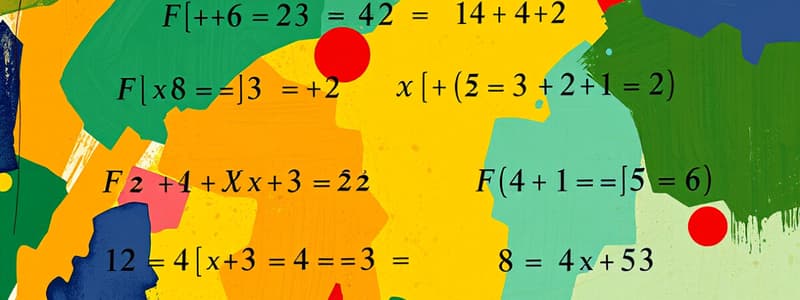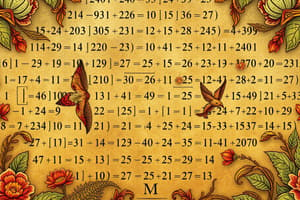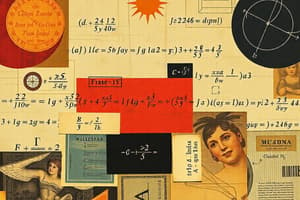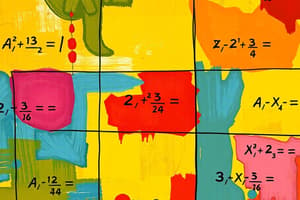Podcast
Questions and Answers
What defines a linear equation?
What defines a linear equation?
- It is an equation where the variables appear only to the first power. (correct)
- It involves fractions with polynomials in the numerator and denominator.
- It consists of a polynomial of three terms.
- It has a degree of two and includes a squared variable.
What is the correct order of operations used when solving algebraic expressions?
What is the correct order of operations used when solving algebraic expressions?
- Addition, Subtraction, Multiplication, Division
- Multiplication, Addition, Exponents, Division
- Addition, Parentheses, Exponents, Multiplication
- Parentheses, Exponents, Multiplication and Division, Addition and Subtraction (correct)
Which of the following represents the quadratic formula?
Which of the following represents the quadratic formula?
- x = (-b ± √(b² - 4ac)) / (2a) (correct)
- x = (-b ± √(b² + 4ac)) / (2a)
- x = (b ± 4ac) / (-2b)
- x = (b ± √(b² - 4ac)) / (2a)
How can we eliminate a variable in a systems of equations?
How can we eliminate a variable in a systems of equations?
Which expression is an example of a polynomial equation?
Which expression is an example of a polynomial equation?
What does a quadratic function graph look like?
What does a quadratic function graph look like?
In the expression 3x + 2, what is the role of '3'?
In the expression 3x + 2, what is the role of '3'?
What graph characteristic defines a linear function?
What graph characteristic defines a linear function?
Which statement about inequalities is true?
Which statement about inequalities is true?
What is the purpose of factoring in algebra?
What is the purpose of factoring in algebra?
Flashcards are hidden until you start studying
Study Notes
Algebra
-
Definition: A branch of mathematics dealing with symbols and the rules for manipulating those symbols to solve equations and represent relationships.
-
Basic Concepts:
- Variables: Symbols (often letters) that represent numbers (e.g., x, y).
- Constants: Fixed values (e.g., 3, -5).
- Expressions: Combinations of variables and constants (e.g., 3x + 2).
- Equations: Statements that two expressions are equal (e.g., 2x + 3 = 7).
-
Operations:
- Addition, subtraction, multiplication, and division of algebraic expressions.
- Order of operations: Parentheses, Exponents, Multiplication and Division (left to right), Addition and Subtraction (left to right) (PEMDAS/BODMAS).
-
Types of Equations:
- Linear Equations: Equations of the first degree (e.g., y = mx + b).
- Quadratic Equations: Equations of the second degree (e.g., ax² + bx + c = 0).
- Polynomial Equations: Equations involving polynomials (e.g., 4x^3 - 2x + 7 = 0).
- Rational Equations: Equations that involve fractions with polynomials in the numerator and denominator.
-
Solving Equations:
- Isolation of Variable: Rearranging the equation to solve for the variable.
- Factoring: Expressing a polynomial as a product of its factors (e.g., x² - 5x + 6 = (x-2)(x-3)).
- Quadratic Formula: For ax² + bx + c = 0, the solutions are given by x = (-b ± √(b² - 4ac)) / (2a).
-
Functions:
- Definition: A relation where each input has a single output (e.g., f(x) = mx + b).
- Types:
- Linear Functions: Graph as straight lines (constant rate of change).
- Quadratic Functions: Graph as parabolas (u-shaped curves).
-
Graphing:
- Coordinate System: Consists of x (horizontal) and y (vertical) axes.
- Plotting Points: Each point is represented as (x, y).
- Slope: Measure of steepness (m = (y₂ - y₁) / (x₂ - x₁)).
-
Inequalities:
- Expressions that use <, >, ≤, or ≥.
- Solutions can be represented on a number line or graphically.
-
Systems of Equations:
- Set of two or more equations with the same variables.
- Can be solved using substitution, elimination, or graphing methods.
-
Applications:
- Used in various fields such as engineering, economics, science, and statistics to model real-world scenarios and solve problems.
Algebra Overview
- Algebra is a mathematical discipline focusing on symbols and their manipulation to solve equations and express relationships.
Basic Concepts
- Variables: Symbols (typically letters like x, y) that denote numbers.
- Constants: Fixed numerical values, such as 3 or -5.
- Expressions: Combinations of variables and constants (e.g., 3x + 2).
- Equations: Statements asserting the equality of two expressions (e.g., 2x + 3 = 7).
Operations in Algebra
- Fundamental operations include addition, subtraction, multiplication, and division of algebraic expressions.
- The order of operations is critical for solving expressions, following PEMDAS/BODMAS guidelines:
- Parentheses, Exponents, Multiplication and Division (left to right), Addition and Subtraction (left to right).
Types of Equations
- Linear Equations: First-degree equations represented as y = mx + b, forming straight lines on a graph.
- Quadratic Equations: Second-degree equations, typically expressed as ax² + bx + c = 0.
- Polynomial Equations: Involve polynomials (e.g., 4x^3 - 2x + 7 = 0).
- Rational Equations: Contain fractions with polynomials in both the numerator and denominator.
Solving Equations
- Isolation of Variable: Rearranging an equation to make a variable the subject.
- Factoring: Breaking down a polynomial into products of simpler expressions (e.g., x² - 5x + 6 = (x-2)(x-3)).
- Quadratic Formula: Provides solutions for quadratic equations in the form ax² + bx + c = 0 as x = (-b ± √(b² - 4ac)) / (2a).
Functions
- A function relates each input to a single output (e.g., f(x) = mx + b).
- Linear Functions: Represent straight-lines with a constant rate of change.
- Quadratic Functions: Create parabolic graphs, depicting U-shaped curves.
Graphing
- The coordinate system comprises horizontal (x) and vertical (y) axes.
- Points are presented in the form (x, y).
- Slope: Indicates steepness, calculated via the formula m = (y₂ - y₁) / (x₂ - x₁).
Inequalities
- Express relationships using <, ≤, or ≥.
- Solutions for inequalities can be illustrated on a number line or through graphical representation.
Systems of Equations
- Consist of two or more equations sharing the same variables.
- Methods for solving include substitution, elimination, and graphical approaches.
Applications of Algebra
- Crucial in fields such as engineering, economics, science, and statistics for modeling real-world scenarios and solving practical problems.
Studying That Suits You
Use AI to generate personalized quizzes and flashcards to suit your learning preferences.




